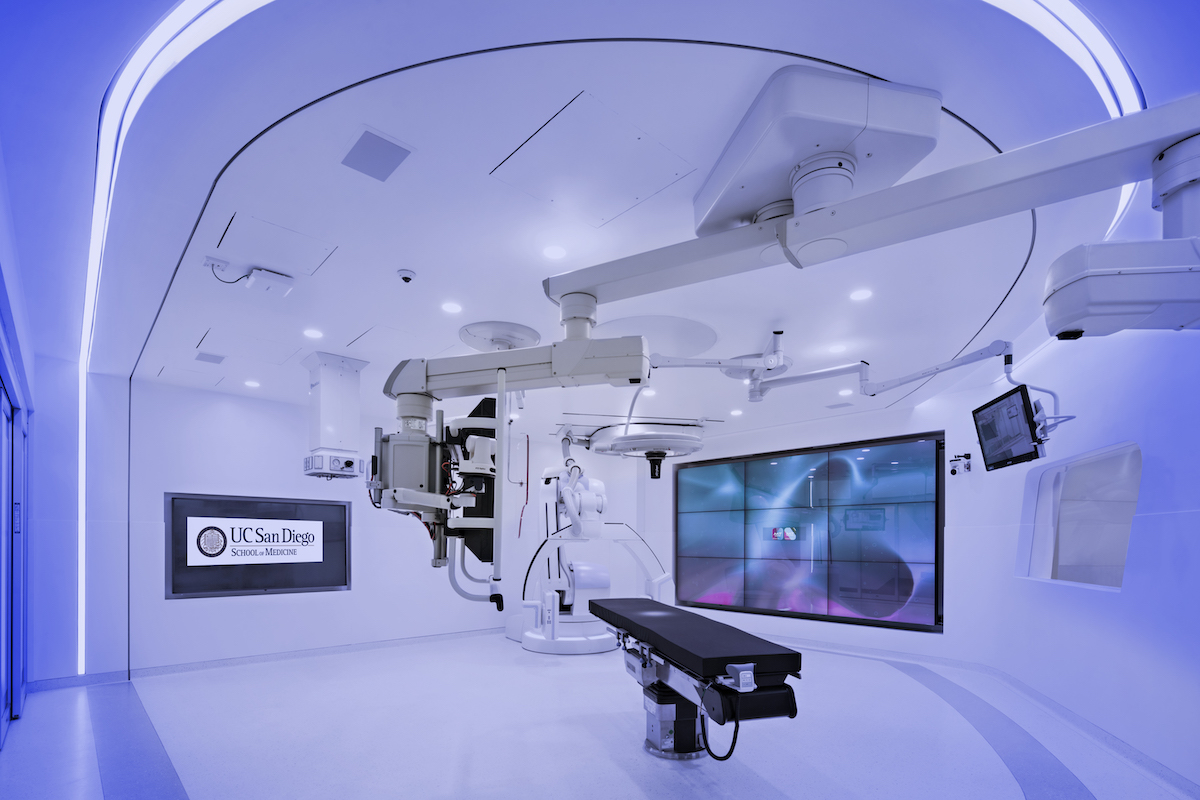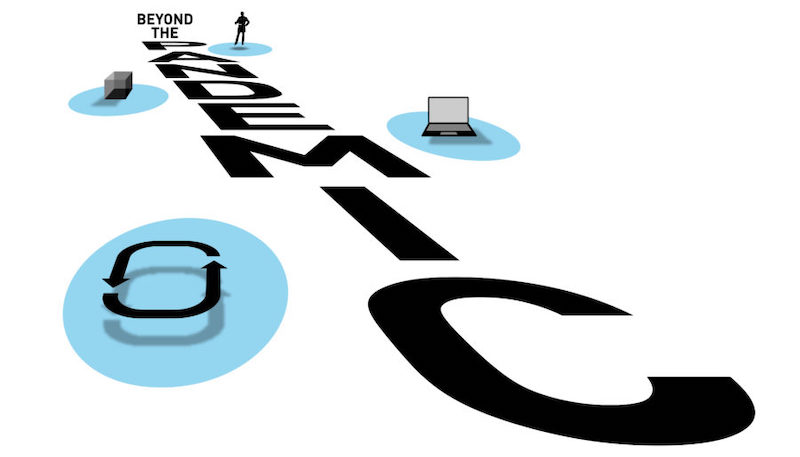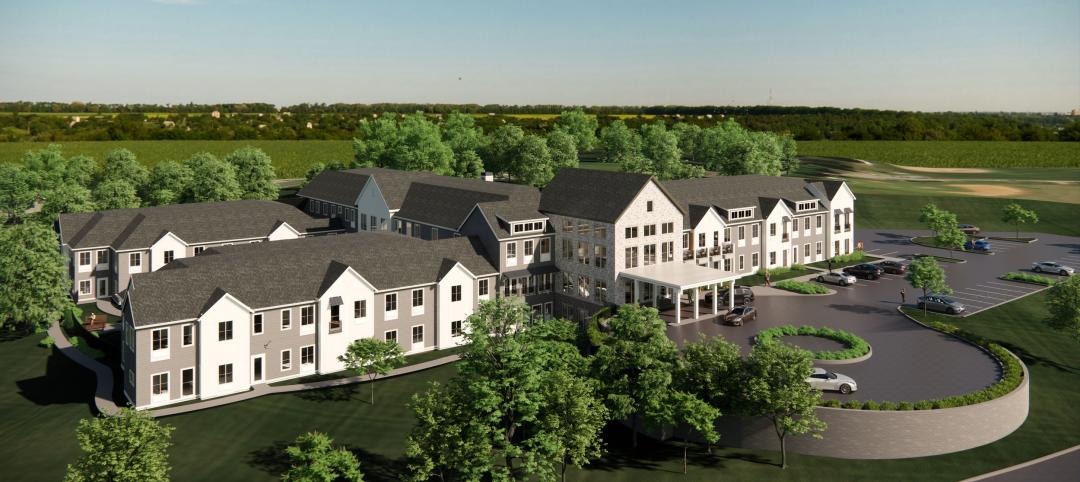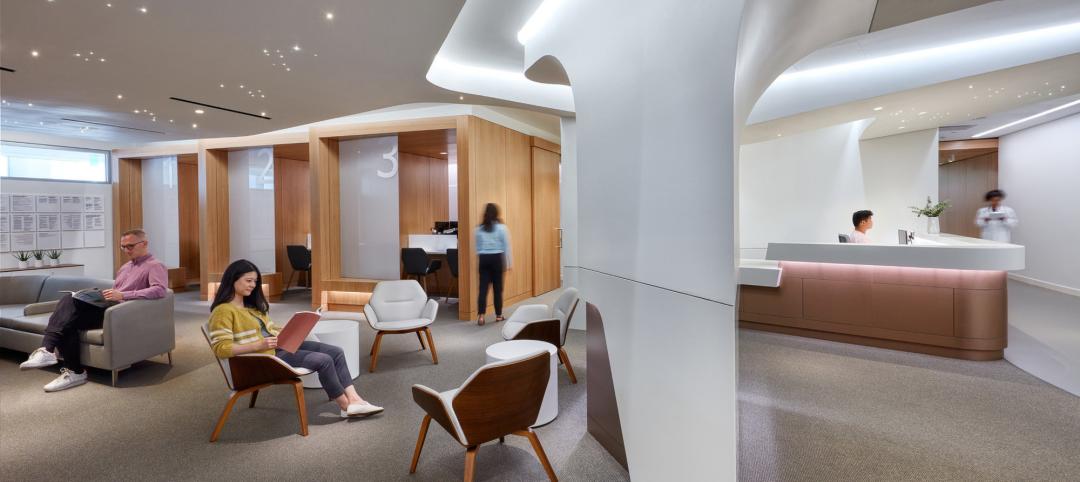WSP USA had an emergency response team in place, a legacy from a previous acquisition. So the firm was ready when healthcare systems sought assistance to increase their capacity to treat infected patients.
Within the nine-story University of Oklahoma Medical Center’s Adult Bed Tower Expansion that’s under construction, WSP got two floors COVID-19 ready in 60 days. Under normal scheduling, those floors wouldn’t have been completed until November. WSP provided the cleaning and decommissioning services, and Turner Construction is the GC.
Around the same time, a building team that included HGA and The Boldt Company was launching a modular isolation-room concept called STAAT Mod (STAAT stands for Strategic, Temporary, Acuity-Adaptable Treatment) that could be assembled and operational in 14 to 28 days, depending on the number of modules used. In late May, Adventist Fort Washington Hospital in Maryland became the first healthcare organization in the nation to accept COVID-19 infected in other critically ill patients in 12 modules with 7,000 sf of space that were assembled in two weeks. Maryland has ordered STAAT Mods for several other locations. And Boldt’s factory in Wisconsin is producing a module per day, and a 16-bed hospital in 11 days.
Other firms, like Leo A Daly and HKS, offered detailed hotel-to-patient care conversion strategies that, in HKS’s case, drew more than 200 people to an April 7 webinar on this topic. The webinar assembled a virtual panel of 40 experts that included representatives from the Army Corps of Engineers, FEMA, and Marriott.
DLR Group worked with King County, Wash., to get quick-response clinics called Assessment & Recovery Centers, with a total of 2,500 beds in a dozen temporary units, available to infected homeless patients in a matter of weeks. Stantec was part of the team working with the Army Corps of Engineers that, in April, converted McCormick Place convention center in Chicago to a 3,000-bed alternate patient care facility. And a team that included HKS took only three weeks to convert an unused wing of a prison in Hagerstown, Md., to a 192-bed facility for treating lower-acuity COVID-19 patients.
These are just a few of the examples of AEC firms stepping forward to assist municipalities and health systems in meeting the surge of virus-infected patients.
“The landscape was changing by the hour,” recalls Mark Chrisman, Vice President and Healthcare Practice Director with Henderson Engineers. He and two colleagues—Jake Katzenberger and Russ Murdock—posted on BD+C’s website their strategy for converting existing buildings to alternate care sites for COVID-19 patients. The authors touched on four conversion scenarios, each with a concentration on airflow and HVAC systems.
The coronavirus exposed cracks in the country’s ability to mobilize and deliver patient services under less-than-ideal and stressful situations.
“Moving healthcare out of the ‘mothership’ [i.e., hospitals] to the community at large wasn’t an epidemic response,” says Michael Compton, AIA, ACHA, EDAC, Healthcare Design Leader with RS&H. “What you didn’t hear from healthcare clients is anything about designing hospitals beyond their normal capacity.”
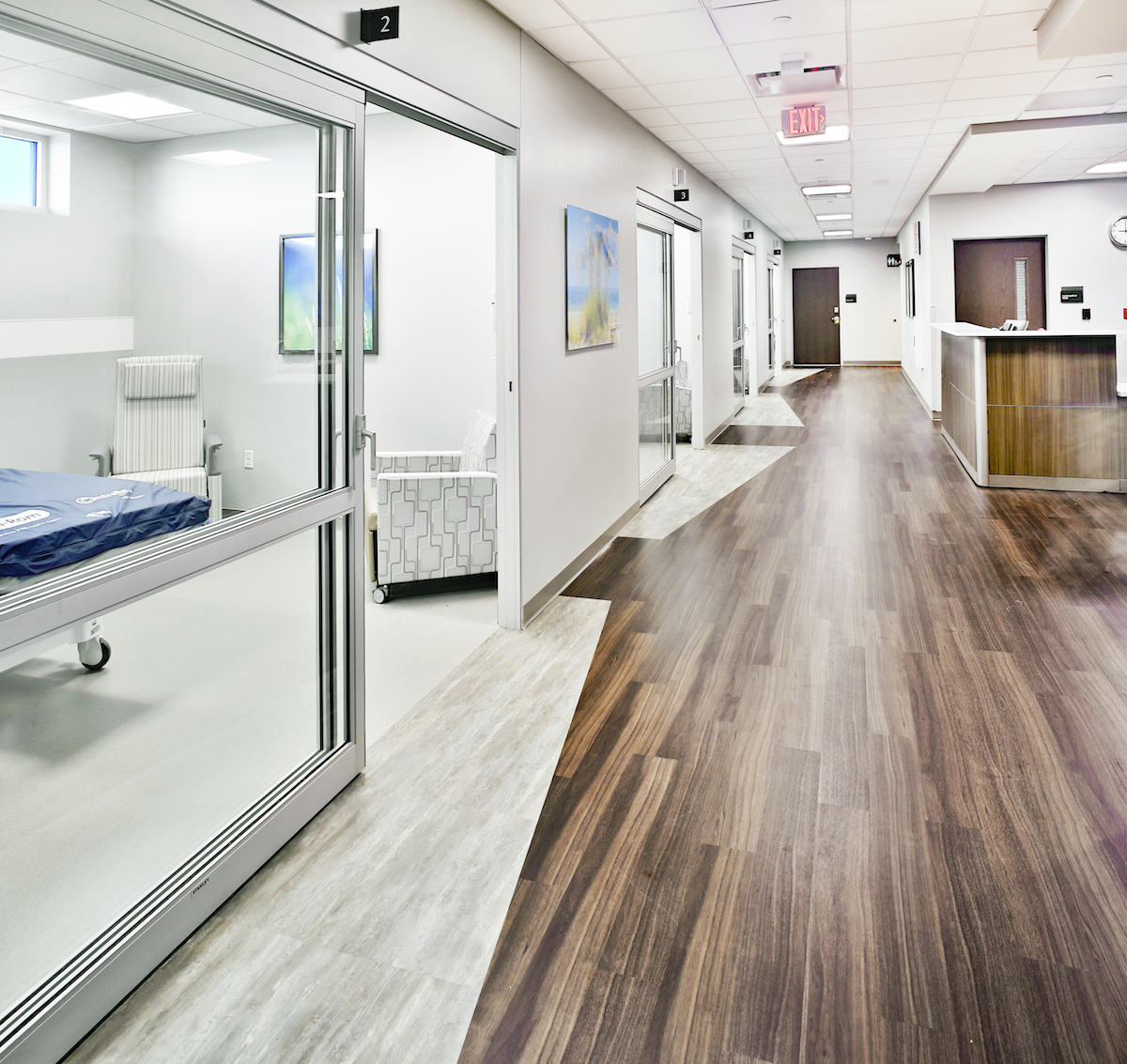
In an example of how hospital beds are becoming more multifunctional, Orlando Hospital in Florida includes the first state-approved surgery center with a room to hold patients over for 24-hour observation. The room is near the floor’s nurse’s station. Photo courtesy RS&H
That mindset, however, could be changing in favor of multifunctionality. RS&H recently completed a surgery center for Orlando Health in Claremont, Fla., that includes the first state-sanctioned 24-hour patient observation unit. Compton adds that legislation has been proposed that would allow patients to stay in surgery centers for 72 hours.
Some clients of Wakefield Beasley & Associates, a design firm that’s part of Nelson Worldwide, “are already talking about installing permanent drive-throughs for virus testing,” says CEO Lamar Wakefield.
Healthcare industry starts from scratch with infection control
There’s no question that the U.S. healthcare industry had some catching up to do. During the pandemic, HDR reposted a paper it published in 2017 that identified 10 principles for protecting patients from infectious diseases. The firm also mobilized its healthcare practice team to capture lessons learned from around the globe, with an eye toward refining its guidelines to prepare for the next pandemic, says Hank Adams, AIA, FACHA, HDR’s Global Director of Health.
“There was no medical facility in the U.S. whose infection control was up to the level of COVID-19,” states Michael Murphy, Founding Principal and Executive Director of MASS Design Group.
In April, MASS Design Group, Mount Sinai Kravis Children’s Hospital and The Mount Sinai Hospital, and Ariadne Labs investigated spaces converted and repurposed for the care of critically ill COVID-19 patients, to illuminate coronavirus capacity planning, interventions, and opportunities. This exercise inferred that hospitals are not designed to easily pivot to support the infrastructural changes needed at the scale of a pandemic surge. The study found variability in such adaptations by floor and unit, and in personal perceptions about risk zones within care units.
Jim Henry, AIA, Senior Vice President and Healthcare Director with CallisonRTKL, observes that too many hospital systems still don’t focus on uncovering the causes for infection spread. Healthcare facilities “have been pretty lax” in controlling their entrances and exits, “so it’s harder to quarantine people.” He’d also like to see far more hospital beds that are ICU-adaptable, although he concedes that such a shift would require code changes in some states.
On a granular level, Henry expects to see greater use of UV lamps and HEPA filters for infection control, and greater demand among patients and caregivers for cleaner surfaces.
‘Until surge capacity and infection control protocols at every entrance to an essential facility are required, we will most likely not be prepared for the next COVID-type event.’
— Michael Compton, AIA, ACHA, EDAC, RS&H
Just how regimented this cleaning becomes, however, remains to be seen. Solvei Neiger, AIA, ACHA, Partner and Healthcare Practice Leader with ZGF Architects, says that while some clients are talking more about antibacterial materials and cleaner airflow, they aren’t ready yet to talk about using antimicrobials.
Perkins and Will’s solutions for infection control now include giving healthcare clients more design options for isolating patients, and for treating day-to-day patients during pandemics.
“The ability to quickly convert into a ‘war zone’ will likely be considered more often,” predicts Tatiana Guimaraes, an Associate Principal with Perkins and Will. “We also see an increased focus on designing around separation and compartmentalization,” says Brian Sykes, an Associate Principal and Healthcare Practice Leader with the firm. That would include separating elevators and other paths of travel, intentional design for PPE equipment storage, and private neonatal ICUs.
It’s worth noting that many of the ideas that AEC firms are floating aren’t new. “UV and indigo lights, HEPA filters, and ionization technology have been around for years,” says Chrisman.
ALSO SEE: Beyond the pandemic - A long-term view of healthcare environments' "new normal"
As healthcare systems emerge from the initial effects of the pandemic and begin the process of reoccupying their ambulatory facilities, expect two significant forces to shape these spaces: new pathways for patient flow, and virtual care.
Thomas Quigley, HOK’s Senior Principal and Director of Healthcare, notes that “universal” hospital rooms have been talked about forever. But what emerged instead, for a variety of reasons, were tiers of rooms—med-surge, step-down, and ICU. Now, hospitals are looking for greater utility and flexibility, even if such rooms cost more to build or retrofit.
Healthcare systems also don’t want to get caught off-guard again during peak demand periods. During the pandemic, Jeff Brand, AIA, EDAC, National Healthcare Leader with Perkins Eastman, toured a site in Brooklyn, N.Y., where a closed hospital was being considered for reopening. More broadly, Brand anticipates that his practice will be asked to create more spaces that can deal with higher-acuity and morbidity cases.
MEP engineer Mazzetti collaborated with HKS on its elaborate high school-to-patient care conversion concept. Jim Pappas, PE, LEED AP, Principal with Mazzetti, says that at least a dozen hospitals that his firm was working with were reopening “mothballed” facilities and re-engineering their rooms for negative pressurization.
New healthcare building types considered post-coronavirus
Moe Goudarzi, PE, Southern California Healthcare Market Leader with Arup, says that some healthcare clients were receptive to upsizing their infrastructure during new construction, such as adding outlets or bigger exhaust systems, as a preemptive maneuver to handle surges.
Several firms expected a greater demand for modernization that would manifest itself in more replacement hospitals that can meet new infection control standards and guidelines. But Goudarzi says that, at least for Arup, this sector’s avidity for new construction divides into two groups: California—whose hospitals also need to be seismic-compliant by 2030 to hold onto their licenses—and the rest of the country, whose healthcare systems typically opt for renovation first.
Chrisman of Hendersen Engineers notes that the Midwest “still needs hospital beds.” Temporary or semi-permanent structures might fill that need, as during the pandemic the Army Corps of Engineers “cleared away a lot of regulatory brush” to allow such structures to supplement permanent hospitals and clinics.
HDR’s 10 Principles of Infection Control
• Understand the bio-contaminant risks unique to healthcare
• Plan and prepare for the unexpected
• Provide flexible patient care space
• Prioritize engineering controls over protocols
• Integrate facility design with operational protocols
• Control contamination through separation
• Eliminate airborne spread of infection agents (HDR suggests anteroom filtration and directional airflow, and HEPA filtration of exhaust and vent openings)
• Choose surfaces and finishes for decontamination
• Minimize the possibility of HVAC system failure
• Define how to measure containment success
“We look for regulators, which are generally behind the curve, to stay out of the way, which they did during the crisis,” says Jim Crabb, PE, LEED AP, Principal–Mechanical with Mazzetti. This was certainly true of the conversion of McCormick Place in Chicago to an alternate patient care facility. “This happened as a result of some relaxation in regulations and reimbursements, and greater cooperation among stakeholders,” says Brenda Bush-Moline, AIA, ACHA, EDAC, Vice President and Sector Leader, Health, with Stantec.
Some changes that AEC firms support, such as making more hospital beds ICU-adaptable, would require code changes. In California, there are specific regulations for ICU unit size, and airborne isolation (one in every 12 beds). “Therein lies the challenge,” says Christopher Naughton, AIA, ACHA, Healthcare Practice Leader and Senior Healthcare Planner with HMC Architects. He elaborates that a medical surgical unit in California only requires isolation for one in every 35 beds. “If we can get past that requirement that would allow for adaptability in times of crisis.”
The rise of telehealth amid COVID-19
Healthcare systems will use what they’ve learned from this pandemic to be better prepared for the next dangerous event. And they’ll expect their AEC partners to be ready with quick responses again.
Goudarzi says that Arup’s clients, post coronavirus, want the firm to predict the future. And it doesn’t require a crystal ball to see that telemedicine and telehealth will help shape that future.
A significant roadblock was lifted when the Centers for Medicare and Medicaid Services broadened access to telehealth in terms of reimbursement for visits and services. During the pandemic, when most doctors and other healthcare professionals weren’t seeing patients face-to-face, the virtual floodgates opened.
ZGF’s Neiger points to one academic medical campus that reported 62% of its clinic visits were via video, versus 0% previously. Another academic medical campus, which had been receiving 1,000 teleheath visits per month, saw that number rise to 1,000/day.
One of Stantec’s healthcare clients saw a 10,000% increase in telehealth visits in one month. And Mazzetti’s Pappas says Marin Health in California reported going from 0% telehealth visits to 70% in a week.
“Technology that limits personal interaction but improves patient care will be in demand,” says Rob Hume, PE, Mazzetti’s Senior Technology Consultant. He’s already seen “virtual sitters”: video and audio monitors for Type-1 patients. He foresees technology being used to track the locations of staff and equipment, to analyze what patients a staff person had been in contact with, and to monitor staff compliance with infection control requirements.
Related Stories
Healthcare Facilities | Mar 18, 2024
A modular construction solution to the mental healthcare crisis
Maria Ionescu, Senior Medical Planner, Stantec, shares a tested solution for the overburdened emergency department: Modular hub-and-spoke design.
Office Buildings | Mar 8, 2024
Conference room design for the hybrid era
Sam Griesgraber, Senior Interior Designer, BWBR, shares considerations for conference room design in the era of hybrid work.
Airports | Jan 15, 2024
How to keep airports functional during construction
Gensler's aviation experts share new ideas about how to make the airport construction process better moving forward.
Apartments | Jan 9, 2024
Apartment developer survey indicates dramatic decrease in starts this year
Over 56 developers, operators, and investors across the country were surveyed in John Burns Research and Consulting's recently-launched Apartment Developer and Investor Survey.
MFPRO+ Special Reports | Jan 4, 2024
Top 10 trends in multifamily rental housing
Demographic and economic shifts, along with work and lifestyle changes, have made apartment living preferable for a wider range of buyers and renters. These top 10 trends in multifamily housing come from BD+C's 2023 Multifamily Annual Report.
Urban Planning | Dec 18, 2023
The impacts of affordability, remote work, and personal safety on urban life
Data from Gensler's City Pulse Survey shows that although people are satisfied with their city's experience, it may not be enough.
Senior Living Design | Oct 30, 2023
Navigating architectural challenges—from 'unbuildable' to unbelievable
Mick Schaefer, AIA, NCARB, LEED GA, recounts the challenges Vessel Architecture & Design had to overcome while designing a state-of-the-art senior living facility.
Healthcare Facilities | Sep 8, 2023
Modern healthcare interiors: Healing and care from the outside in
CO Architects shares design tips for healthcare interiors, from front desk to patient rooms.
Codes and Standards | Jul 19, 2023
Office leasing in major markets by financial services firms rebounds to pre-pandemic norms
Though the pandemic led to reductions in office leasing by financial services firms in gateway markets, a recent report by JLL found a notable leasing resurgence by those firms.
Multifamily Housing | Jun 29, 2023
5 ways to rethink the future of multifamily development and design
The Gensler Research Institute’s investigation into the residential experience indicates a need for fresh perspectives on residential design and development, challenging norms, and raising the bar.


